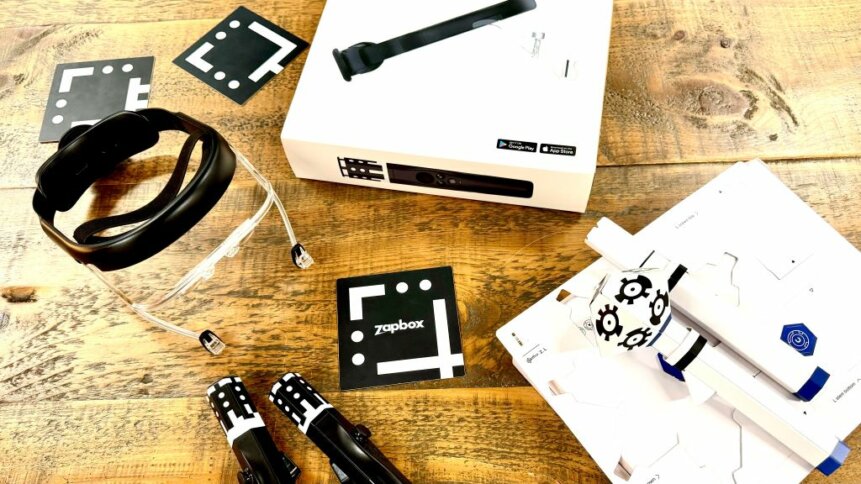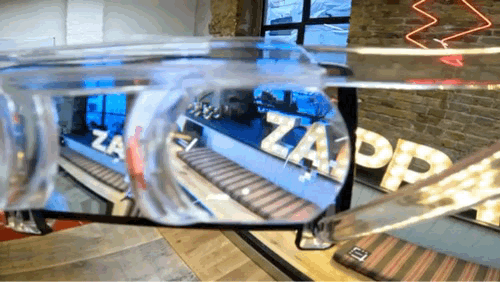Enterprise VR gets price drop thanks to smartphone headset

|
Getting your Trinity Audio player ready...
|
Factoring in how expertise learned in VR can translate remarkably well into the real-world – for example, bringing helicopter engineers up to speed on maintenance in record time or helping to plan better factories – strengthens the case for firms exploring digital training opportunities. Plus, you have the cost-savings and convenience that go hand-in-hand with remote learning. However, when budgets are tight, investing in new hardware may not appeal. What’s needed to spread the benefits of immersive, industrially relevant experiences more widely is a much more affordable VR headset.
Being able to use technology that you already own lowers the barrier to adoption. And, for many of us, the heart of what’s needed to engineer an affordable VR headset is just an arm’s length away in the form of our smartphones. Flagship mobile devices have pin-sharp displays, fast-rendering graphics, and even wide-angle camera lenses for video passthrough to fuse real and virtual environments in mixed reality.
It’s often said that commercial VR headsets are basically smartphones strapped to your head, and – over several years – UK-based Zappar has been refining that concept in the form of its mixed-reality Zapbox project. What’s more, the product – now shipping in the UK, Europe, and US – doesn’t just provide users with an affordable VR headset with a 100 deg FoV, it comes with 6DoF controllers too.
To find out more, TechHQ visited Zappar’s London headquarters to speak with the team and, importantly, put the firm’s affordable VR headset solution to the test. When it comes to evaluating the broad family of extended reality (XR) technology, nothing beats sampling the technology firsthand.
First impressions of the Zapbox mixed-reality headset
To use the Zapbox, you begin by simply clipping in your iPhone. Android support is in the works, with fewer device choices making Apple’s ecosystem a simpler starting point for the project. Simon Taylor, Co-Founder and Chief Research & Development Officer at Zappar, explained that Apple smartphones from the iPhone 11 upward will provide the best experience.
The affordable VR headset is light and comfortable to wear. Because of the open design, you don’t feel as blocked out from your surroundings compared with wearing a closed facial interface – for example, as found on Meta’s Quest VR headsets. Given these characteristics, it feels like mixed reality experiences will be the sweet spot for the Zapbox. And TechHQ had the chance to try out some of the firm’s software demos.

Mixed reality through the lens: can you see a chess bot on the Zappar sofa? Testing out the Zapbox in London, UK.
Touching on Zappar’s backstory reveals why the company is well placed to enable mixed reality experiences using an affordable VR headset featuring a smartphone (and controllers, which we’ll get to in a moment). For many years, Zappar has been helping global brands such as Puma, Vodafone, Disney, and many others connect with consumers through innovative augmented reality smartphone experiences.
You may have bought a product inviting you to discover more by aiming your mobile camera at a QR code on the packaging. Considering examples from Zappar’s portfolio of work, consumers following such a digital trail may see a virtual history book drop from the sky and open up alongside the actual product in the camera view. Continuing the AR experience, the smartphone screen could fill with mixed-reality animations telling the target product’s story in a memorable way.
Zappar’s first step in adding to its core AR business by offering existing clients and new customers an affordable VR headset was to begin with cardboard. “The design worked much better than anyone expected,” Taylor told TechHQ. “It showed that you could have a tangible experience with an existing phone.”
Going beyond the capabilities of Google’s fold-out cardboard VR viewer, Zappar added controllers with orientation markers and even triggers that could be read thanks to a traveling indicator, which moved when the cardboard button was squeezed. And given the promise of adding to the utility of a device that millions of people already own – a smartphone – the team went from cardboard to having an industrial design available in molded plastic.
As well as Bluetooth, the developers added inertial measurement unit (IMU) capabilities to their controller design, which provides fallback for when the optically-tracked units move outside the smartphone’s field of view. As mentioned, Zappar has apps available to give users a taste of what’s possible using a smartphone-powered affordable VR headset and controllers.
Also, to boost the amount of compatible content, its possible to bootstrap from other ecosystems. For example, Taylor explains that the Zapbox platform is compatible with WebXR standards, which makes it straightforward for VR software developers to port titles across.
On site, TechHQ got to experience a block-building mixed-reality tool where digital assets could be placed on top of items seen in the real-world. And, although the software was simply a demo app, it was clear how such a design could be used in getting staff up to speed on a complex assembly process, for example.
The all new zapbox from @ZapparApp is looking 👀 fantastic at AWE USA in Santa Clara#AWEUSA #AWEUSA2023 #AWE2023 #community #augmentedreality #virtualreality #XR #VR #events pic.twitter.com/UvW1gxMZnV
— Anything World (@_AnythingWorld) June 1, 2023
Zapbox users also get to play mixed-reality chess and pool, which includes a virtual bot – in the case of chess – giving feedback on the moves made on the board. Table-top experiences translate well into VR, and the addition of mixed reality, using passthrough video via the smartphone’s wide-angle lens and camera, makes it feel like the digital on-screen graphics are in the room.
As well as controllers, the affordable VR headset comes with so-called origin markers that give the digital graphics, which may be shared between users (imagine two people playing chess or pool remotely), a common reference point.
Kirk Ewing, Zapbox General Manager, points out that there are hundreds of millions of smartphones out there that could be repurposed as mixed reality devices using the headset and controller combination. Enterprises that already provide staff with mobiles could introduce VR into their organizations with little additional cost.
Zappar is by no means the only company offering cellphone-compatible VR headsets. But its well-engineered design is noteworthy and plays to the strengths of the firm’s proven capability in AR. And there’s one more thing.
How to watch Apple spatial video without a Vision Pro
Spending time with the Zappar team, it’s clear that they are an enthusiastic bunch. And who wouldn’t be if you get to explore the creative worlds of augmented and mixed reality? But on the day TechHQ arrived, there was an extra level of excitement in the room.
Apple’s iOS 17.2 update had dropped in beta for developers that morning, which – as the US tech giant’s release notes reveal – includes the ability to ‘capture spatial video with remarkable depth on iPhone 15 Pro to view in 3D in the Photos app on Apple Vision Pro’.
But the Vision Pro isn’t expected until 2024 and will cost thousands of dollars. Is there any way for iPhone 15 Pro users to experience spatial video directly from their smartphones? Zappar’s Chief R&D Officer had been running tests with the Zapbox to find out, and when TechHQ turned up, the first thing he showed was how to watch Apple spatial video without a Vision Pro.
With iOS 17.2 installed, users can record spatial video – having turned on spatial video capture in Settings > Camera > Formats – on their iPhone 15 Pro and watch back the 3D stereoscopic experience on their smartphone clipped into an $80 Zapbox.
The more time that we get to spend with commercial XR technology, the stronger the feeling that 2024 could be a breakthrough year for enterprise VR. And seeing the Zapbox in action adds to that belief.









